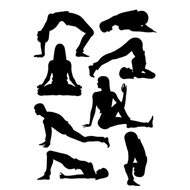Inclined Plane (Purvottanasana)
Inclined Plane
The Inclined Plane Pose or the Reversed Plank Pose or Purvottanasana is a pose that stretches the front of the body from the shoulders down to the toes and stimulates the energy pathways in the body. The name derives from the Sanskrit word purva which means the east or the front of the body and purvotta which means an intense stretching of the front of the body.
This asana is the counter pose to the Forward Bend or Paschimottanasana.
Steps
Here are the steps of the Inclined Plane Pose or Purvottanasana.
- Sit in the Dandasana or Staff Pose.
- Your legs should be stretched out in front of you with the toes pointed towards the ceiling.
- Your hands should be placed several inches behind your back and hips, with the palms flat on the ground and the fingers pointed forward towards your back.
- Your back and spine should be upright at a 90° angle to the floor.
- Bend both your knees and place your feet flat on the floor with the heels about a foot away from your buttocks
- Your big toes should be curled inwards.
- Begin exhaling and simultaneously press your hands and the inner part of your feet against the floor.
- Inhale and lift your hips off the floor, upwards until you reach the reverse tabletop position.
- Your torso and thighs should be approximately parallel to the floor while your arms and shins should be approximately perpendicular to the floor.
- Slowly straighten one leg at a time without lowering your hips.
- Lift your hips still higher.
- Do not tighten your buttocks while doing this.
- Press your shoulder blades against your back so as to support the lifting of your chest.
- Slowly drop your head backwards.
- Hold this position for 30 seconds.
- Slowly lower yourself and sit in the Dandasana position while exhaling.
Precautions
Precautions while performing the Inclined Plane Pose include:
- If you suffer from hyperthyroidism, then do this asana without bending the head backwards.
- If you have a neck injury, support your head on a chair seat or some other support.
Do not perform this pose if you have any of the following:
- Wrist injury
- Chronic leg injury
- Hip injury
- Arm injury
- Lower back problem
- Hypertension
- Hernia
- Stomach ulcers
- Cervical spondylosis
Beginner’s Tips
A beginner’s tip for the Inclined Plane Pose is the use of a chair for support in the initial phases. You can practice by sitting on the front edge of the seat and wrapping your hands around the back. Inhale and lift your pelvis off the seat of the chair and then slowly extend each leg.
Benefit to the Body
The Inclined Plane Pose imparts many benefits to different parts of the body. Some of these benefits include:
- The muscles of the back, legs and shoulders are stretched during this asana.
- The spine becomes suppler as a result.
- The stretching of the spine improves the functioning of the parasympathetic nervous system.
- The wrists become stronger and suppler at the same time.
- The ankles become suppler and stronger too.
- It improves the sense of balance.
- The abdominal muscles are stretched and the organs in the region massaged.
- The endocrine gland benefits greatly from this pose.
- Kidney function improves as does diuresis.
- It is beneficial to the sex glands.
- Women benefit with the ovarian function returning to normal.
- It helps to impart a sense of calm.
Therapeutic Applications
Therapeutic applications for the Inclined Plane Pose include:
- Fatigue
- Constipation
- Kidney disorders
Variations
Variations for the Inclined Plane Pose include the Table Top Variation.
This is how it is done.
- Sit in the Dandasana or Staff Pose.
- Bend your knees and place your feet flat on the floor.
- Your heels should be about 1 foot away from your buttocks.
- Your arms should be behind your back with the palms lying flat on the ground facing forward.
- Begin exhaling and simultaneously press your hands and the inner part of your feet against the floor.
- Inhale and lift your hips off the floor, upwards until you reach the reverse tabletop position.
- Your torso and thighs should be approximately parallel to the floor while your arms and shins should be approximately perpendicular to the floor.
- Slowly let your head drop backwards.
- Hold the pose for about 30 minutes.
- Exhale and slowly return to the Dandasana position.
Preparatory Poses
Preparatory poses for the Inclined Plane Pose include:
- Gomukhasana (arms only) or Cow-face Pose
- Supta Virasana or Reclining Hero Pose
- Setu Bandha Sarvangasana or Bridge Pose
- Dhanurasana or Bow Pose or Upward Wheel Pose
Follow Up Poses
- Paschimottanasana or “The Seated Forward Bend”
- Adho Mukha Svanasana or “The Downward Facing Dog” – It is one of the poses in the Sun Salutation or Surya Namaskar sequence.



